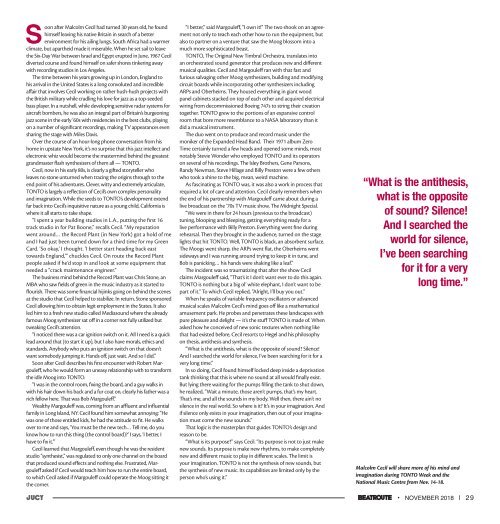BeatRoute Magazine AB Edition November 2018
BeatRoute Magazine is a monthly arts and entertainment paper with a predominant focus on music – local, independent or otherwise. The paper started in June 2004 and continues to provide a healthy dose of perversity while exercising rock ‘n’ roll ethics. Currently BeatRoute’s AB edition is distributed in Calgary, Edmonton (by S*A*R*G*E), Banff and Canmore. The BC edition is distributed in Vancouver, Victoria and Nanaimo. BeatRoute (AB) Mission PO 23045 Calgary, AB T2S 3A8 E. editor@beatroute.ca BeatRoute (BC) #202 – 2405 E Hastings Vancouver, BC V5K 1Y8 P. 778-888-1120
BeatRoute Magazine is a monthly arts and entertainment paper with a predominant focus on music – local, independent or otherwise. The paper started in June 2004 and continues to provide a healthy dose of perversity while exercising rock ‘n’ roll ethics.
Currently BeatRoute’s AB edition is distributed in Calgary, Edmonton (by S*A*R*G*E), Banff and Canmore. The BC edition is distributed in Vancouver, Victoria and Nanaimo. BeatRoute (AB) Mission PO 23045 Calgary, AB T2S 3A8 E. editor@beatroute.ca BeatRoute (BC) #202 – 2405 E Hastings Vancouver, BC V5K 1Y8 P. 778-888-1120
You also want an ePaper? Increase the reach of your titles
YUMPU automatically turns print PDFs into web optimized ePapers that Google loves.
Soon after Malcolm Cecil had turned 30 years old, he found<br />
himself leaving his native Britain in search of a better<br />
environment for his ailing lungs. South Africa had a warmer<br />
climate, but apartheid made it miserable. When he set sail to leave<br />
the Six-Day War between Israel and Egypt erupted in June, 1967 Cecil<br />
diverted course and found himself on safer shores tinkering away<br />
with recording studios in Los Angeles.<br />
The time between his years growing up in London, England to<br />
his arrival in the United States is a long convoluted and incredible<br />
affair that involves Cecil working on rather hush-hush projects with<br />
the British military while cradling his love for jazz as a top-seeded<br />
bass player. In a nutshell, while developing sensitive radar systems for<br />
aircraft bombers, he was also an integral part of Britain’s burgeoning<br />
jazz scene in the early ‘60s with residencies in the best clubs, playing<br />
on a number of significant recordings, making TV appearances even<br />
sharing the stage with Miles Davis.<br />
Over the course of an hour-long phone conversation from his<br />
home in upstate New York, it’s no surprise that this jazz intellect and<br />
electronic whiz would become the mastermind behind the greatest<br />
grandmaster flash synthesizers of them all — TONTO.<br />
Cecil, now in his early 80s, is clearly a gifted storyteller who<br />
leaves no stone unturned when tracing the origins through to the<br />
end point of his adventures. Clever, witty and extremely articulate,<br />
TONTO is largely a reflection of Cecil’s own complex personality<br />
and imagination. While the seeds to TONTO’s development extend<br />
far back into Cecil’s inquisitive nature as a young child, California is<br />
where it all starts to take shape.<br />
“I spent a year building studios in L.A., putting the first 16<br />
track studio in for Pat Boone,” recalls Cecil. “My reputation<br />
went around… the Record Plant (in New York) got a hold of me<br />
and I had just been turned down for a third time for my Green<br />
Card. ‘So okay,’ I thought. ‘I better start heading back east<br />
towards England,’” chuckles Cecil. On route the Record Plant<br />
people asked if he’d stop in and look at some equipment that<br />
needed a “crack maintenance engineer.”<br />
The business mind behind the Record Plant was Chris Stone, an<br />
MBA who saw fields of green in the music industry as it started to<br />
flourish. There was some financial hijinks going on behind the scenes<br />
at the studio that Cecil helped to stabilize. In return, Stone sponsored<br />
Cecil allowing him to obtain legit employment in the States. It also<br />
led him to a fresh new studio called Mediasound where the already<br />
famous Moog synthesizer sat off in a corner not fully utilized but<br />
tweaking Cecil’s attention.<br />
“I noticed there was a car ignition switch on it. All I need is a quick<br />
lead around that (to start it up), but I also have morals, ethics and<br />
standards. Anybody who puts an ignition switch on that doesn’t<br />
want somebody jumping it. Hands off, just wait. And so I did.”<br />
Soon after Cecil describes his first encounter with Robert Margouleff,<br />
who he would form an uneasy relationship with to transform<br />
the idle Moog into TONTO.<br />
“I was in the control room, fixing the board, and a guy walks in<br />
with his hair down his back and a fur coat on, clearly his father was a<br />
rich fellow here. That was Bob Margouleff.”<br />
Wealthy Margouleff was, coming from an affluent and influential<br />
family in Long Island, NY. Cecil found him somewhat annoying: “He<br />
was one of those entitled kids, he had the attitude to fit. He walks<br />
over to me and says, ‘You must be the new tech… Tell me, do you<br />
know how to run this thing (the control board)?’ I says, ‘I better, I<br />
have to fix it.’”<br />
Cecil learned that Margouleff, even though he was the resident<br />
studio “synthesist,” was regulated to only one channel on the board<br />
that produced sound effects and nothing else. Frustrated, Margouleff<br />
asked if Cecil would teach him how to run the entire board,<br />
to which Cecil asked if Margouleff could operate the Moog sitting it<br />
the corner.<br />
“I better,” said Margouleff, “I own it!” The two shook on an agreement<br />
not only to teach each other how to run the equipment, but<br />
also to partner on a venture that saw the Moog blossom into a<br />
much more sophisticated beast.<br />
TONTO, The Original New Timbral Orchestra, translates into<br />
an orchestrated sound generator that produces new and different<br />
musical qualities. Cecil and Margouleff ran with that fast and<br />
furious salvaging other Moog synthesizers, building and modifying<br />
circuit boards while incorporating other synthesizers including<br />
ARPs and Oberheims. They housed everything in giant wood<br />
panel cabinets stacked on top of each other and acquired electrical<br />
wiring from decommissioned Boeing 747s to string their creation<br />
together. TONTO grew to the portions of an expansive control<br />
room that bore more resemblance to a NASA laboratory than it<br />
did a musical instrument.<br />
The duo went on to produce and record music under the<br />
moniker of the Expanded Head Band. Their 1971 album Zero<br />
Time certainly turned a few heads and opened some minds, most<br />
notably Stevie Wonder who employed TONTO and its operators<br />
on several of his recordings. The Isley Brothers, Gene Parsons,<br />
Randy Newman, Steve Hillage and Billy Preston were a few others<br />
who took a shine to the big, mean, weird machine.<br />
As fascinating as TONTO was, it was also a work in process that<br />
required a lot of care and attention. Cecil clearly remembers when<br />
the end of his partnership with Margouleff came about during a<br />
live broadcast on the ‘70s TV music show, The Midnight Special.<br />
“We were in there for 24 hours (previous to the broadcast)<br />
tuning, blooping and bleeping, getting everything ready for a<br />
live performance with Billy Preston. Everything went fine during<br />
rehearsal. Then they brought in the audience, turned on the stage<br />
lights that hit TONTO. Well, TONTO is black, an absorbent surface.<br />
The Moogs went sharp, the ARPs went flat, the Oberheims went<br />
sideways and I was running around trying to keep it in tune, and<br />
Bob is panicking… his hands were shaking like a leaf.”<br />
The incident was so traumatizing that after the show Cecil<br />
claims Margouleff said, “That’s it I don’t want ever to do this again.<br />
TONTO is nothing but a big ol’ white elephant, I don’t want to be<br />
part of it.” To which Cecil replied, “Alright, I’ll buy you out.”<br />
When he speaks of variable frequency oscillators or advanced<br />
musical scales Malcolm Cecil’s mind goes off like a mathematical<br />
amusement park. He probes and penetrates these landscapes with<br />
pure pleasure and delight — it’s the stuff TONTO is made of. When<br />
asked how he conceived of new sonic textures when nothing like<br />
that had existed before, Cecil resorts to Hegel and his philosophy<br />
on thesis, antithesis and synthesis.<br />
“What is the antithesis, what is the opposite of sound? Silence!<br />
And I searched the world for silence, I’ve been searching for it for a<br />
very long time.”<br />
In so doing, Cecil found himself locked deep inside a deprivation<br />
tank thinking that this is where no sound at all would finally exist.<br />
But lying there waiting for the pumps filling the tank to shut down,<br />
he realized, “Wait a minute, those aren’t pumps, that’s my heart.<br />
That’s me, and all the sounds in my body. Well then, there ain’t no<br />
silence in the real world. So where is it? It’s in your imagination. And<br />
if silence only exists in your imagination, then out of your imagination<br />
must come the new sounds.”<br />
That logic is the masterplan that guides TONTO’s design and<br />
reason to be.<br />
“What is its purpose?” says Cecil. “Its purpose is not to just make<br />
new sounds. Its purpose is make new rhythms, to make completely<br />
new and different music to play in different scales. The limit is<br />
your imagination. TONTO is not the synthesis of new sounds, but<br />
the synthesis of new music. Its capabilities are limited only by the<br />
person who’s using it.”<br />
“What is the antithesis,<br />
what is the opposite<br />
of sound? Silence!<br />
And I searched the<br />
world for silence,<br />
I’ve been searching<br />
for it for a very<br />
long time.”<br />
Malcolm Cecil will share more of his mind and<br />
imagination during TONTO Week and the<br />
National Music Centre from Nov. 14-18.<br />
JUCY BEATROUTE • NOVEMBER <strong>2018</strong> | 29


















